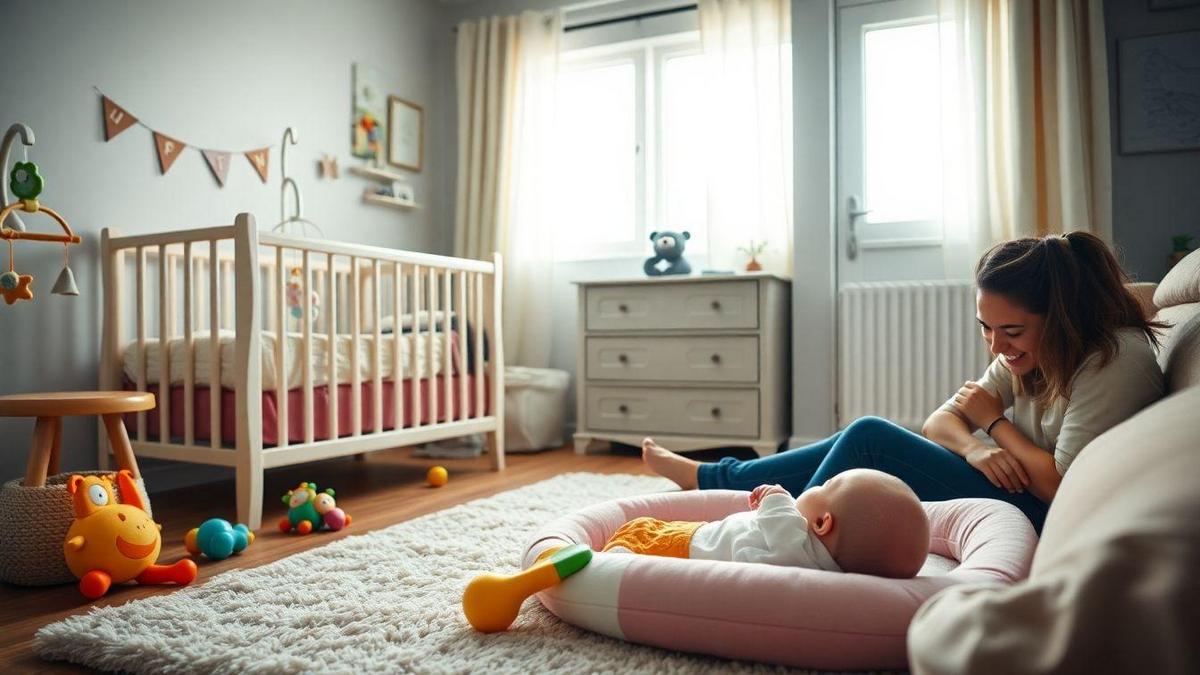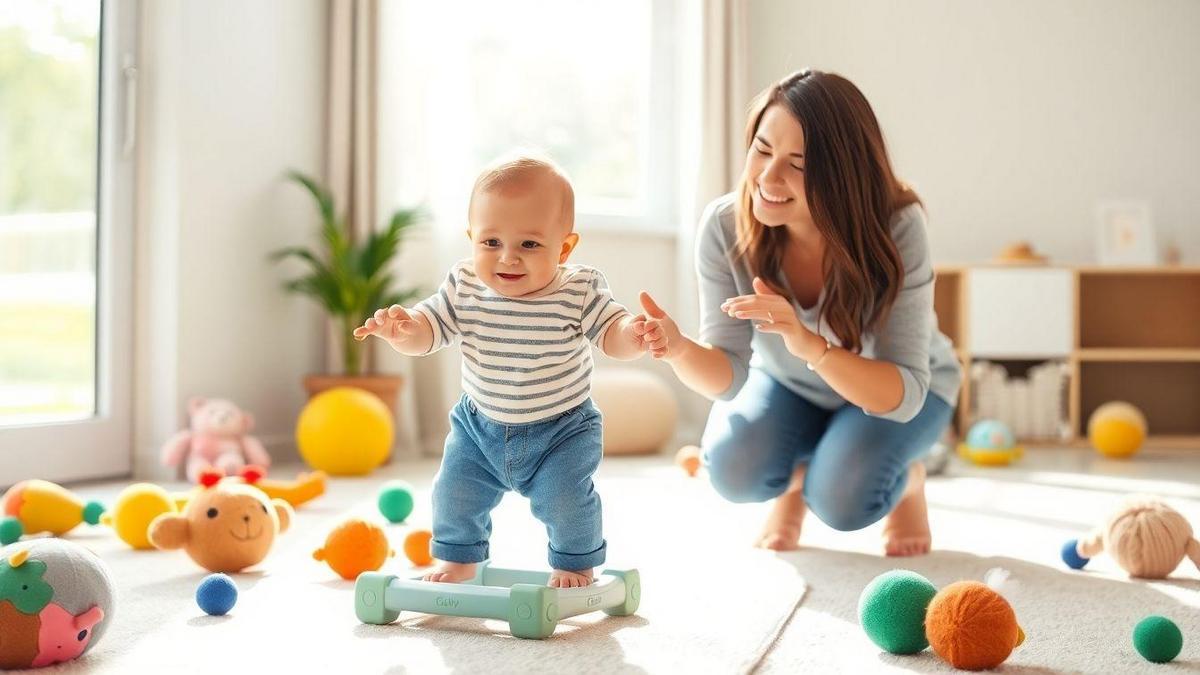When to encourage your baby to walk is an exciting question every parent asks. In this article, you’ll dive into baby development milestones and learn about the signs that show your little one is ready to take those first steps. You’ll discover how to balance encouragement and patience, create a safe walking environment, and explore fun exercises to boost their skills. Plus, we’ll talk about how to celebrate their progress while keeping safety a top priority. Get ready to support your baby’s walking journey!
Key Insights
- Start with tummy time to build strength.
- Use supportive shoes for safety.
- Create a safe walking space at home.
- Encourage walking with fun games.
- Be patient and celebrate small steps.

Understanding Baby Development Milestones
Key Milestones in Walking Development
When it comes to your baby’s journey to walking, there are some key milestones you should keep an eye on. Most babies start to walk between 9 and 15 months. Here’s a quick rundown of what you might see as your little one develops their walking skills:
| Age Range | Milestone |
|---|---|
| 6-9 Months | Pulls up to stand |
| 9-12 Months | Takes first steps (usually while holding onto something) |
| 12-15 Months | Walks independently |
| 15-18 Months | Walks well, may start to run |
These milestones can vary from baby to baby, so don’t stress if your child is a bit behind or ahead. Every child has their own pace!
Signs Your Baby is Ready to Walk
You might notice some signs that your baby is gearing up to take those first steps. Here are a few key indicators:
- Pulling up: If your baby is pulling themselves up to stand, they are getting stronger.
- Cruising: This is when they walk while holding onto furniture for support.
- Balance: If they can stand without holding onto anything for a few seconds, they are getting close!
Pay attention to these signs. They show that your baby is building the strength and confidence needed to walk.
Importance of Recognizing Developmental Stages
Recognizing these developmental stages is crucial. It helps you understand where your baby is in their growth. When you know what to look for, you can offer the right support. For instance, if your baby is ready to walk, you might want to create a safe space for them to explore.
Being aware of these milestones can also help you celebrate your baby’s achievements. Each step they take is a big deal! So, when should you quando incentivar bebe caminhar? When you see those signs, encourage them gently.
When to Encourage Your Baby to Walk
Ideal Age Range for Walking
So, you’re wondering when to encourage your baby to walk? Well, most little ones take their first steps between 9 to 15 months. However, every baby is different. Some might start walking as early as 8 months, while others may take their sweet time until they’re 18 months or older.
Here’s a quick breakdown of what you might see:
| Age | Milestone |
|---|---|
| 8-12 months | Pulling up to stand |
| 9-15 months | Taking first steps |
| 12-18 months | Walking confidently |
| 18 months | Running and climbing |
Factors Influencing Walking Readiness
Now, you might be curious about what influences when your baby is ready to walk. Here are some key factors:
- Physical Development: Babies need strong muscles and balance. Tummy time helps build those muscles! For more on tummy time, check out our guide on helping your baby learn to crawl.
- Personality: Some babies are adventurous and eager to explore, while others may be cautious.
- Environment: A safe space to practice walking can make a big difference. Clear away obstacles so they have room to roam.
Balancing Encouragement and Patience
Encouraging your little one is important, but so is being patient. You don’t want to rush them. Here’s how to strike that balance:
- Cheer Them On: Celebrate their attempts! A little clapping and cheering can boost their confidence.
- Be There: Hold their hands or let them use furniture for support. Just be nearby to catch them if they stumble.
- Let Them Lead: If they’re not ready, that’s okay! Let them take their time.
Remember, every baby has their own pace. You’re not just watching them grow; you’re supporting them as they take those first big leaps into independence.
Safe Practices for Encouraging Walking
Creating a Safe Walking Environment
When you think about taking those first steps with your little one, safety should be at the top of your list. A safe walking environment is key to helping your baby feel confident. Here are some simple ways to create that space:
- Clear the Path: Make sure there are no toys or furniture in the way. A clear path means fewer chances of tripping.
- Soft Surfaces: If possible, let your baby walk on soft surfaces like grass or carpet. This helps if they fall.
- Good Lighting: Keep the area well-lit, so your baby can see where they’re going. Dim spaces can be tricky and scary.
The Role of Supportive Gear
Supportive gear can make a big difference in your baby’s walking journey. Think about these items:
- Walking Shoes: Choose shoes that fit well and offer support. Look for shoes with a flexible sole and a snug fit.
- Knee Pads: If your baby is still learning, knee pads can protect those little knees from scrapes.
- Harnesses: For outdoor adventures, a harness can help keep your baby safe while they explore.
Tips for Physical Support While Walking
Sometimes, a little extra help goes a long way. Here are some tips to support your baby while they walk:
- Hold Their Hands: Grab their hands to give them balance. It’s like being their personal cheerleader!
- Stay Close: Walk beside them. Your presence can boost their confidence.
- Encourage Them: Celebrate every step! A little praise can motivate them to keep going.
| Tip | Description |
|---|---|
| Hold Their Hands | Provides balance and support |
| Stay Close | Boosts confidence with your presence |
| Encourage Them | Praising helps to motivate and build confidence |
Fun Exercises to Boost Walking Skills
Engaging Activities for Your Baby
Getting your baby to walk can be a fun adventure! There are plenty of activities that can make walking practice enjoyable. Here are some ideas:
- Push Toys: Toys that your baby can push will help them balance. Look for ones that are sturdy and colorful.
- Obstacle Courses: Create a mini obstacle course with pillows and soft toys. Encourage your baby to walk over and around them.
- Dance Parties: Put on some lively music and dance! Your baby will love moving to the beat and might even take a few steps on their own.
- Treasure Hunts: Hide toys around the room and encourage your baby to walk to find them. This makes walking feel like a game!
How to Incorporate Play into Walking Practice
Playtime is a great way to help your baby practice walking. Here are some fun ways to mix play with walking:
- Follow the Leader: Walk around the house and have your baby follow you. Make it silly by adding funny movements!
- Interactive Games: Play games like “Simon Says” using walking commands. This keeps things exciting and encourages movement.
- Playdates: Let your baby walk with other little ones. Seeing friends walk can inspire them to try it too.
- Storytime with Movement: Read a story that involves walking or moving. Act it out together to keep your baby engaged.
Benefits of Play for Motor Skills Development
Playing is not just fun; it also helps your baby’s motor skills grow. Here’s how:
| Benefit | Description |
|---|---|
| Improves Balance | Activities that involve movement help your baby learn to balance. |
| Builds Strength | Walking and playing strengthen their legs and core muscles. |
| Enhances Coordination | Fun games improve hand-eye coordination and overall movement skills. |
| Boosts Confidence | As your baby masters walking, they gain confidence to explore more. |
When you think about how to quando incentivar bebe caminhar, remember that play is key. It keeps your baby motivated and excited to walk.

Building Confidence in Your Baby’s Walking
Encouraging Independence in Walking
As your little one starts to explore the world on their feet, encouraging independence is key. You can do this by creating a safe space for them to practice. Clear away any obstacles that might trip them up. Place soft mats or cushions on the floor to soften any falls.
You can also use furniture as a guide. Encourage your baby to pull up on couches or tables. This helps them learn balance and build strength. Remember, every step they take is a step towards independence!
Positive Reinforcement Techniques
Positive reinforcement can work wonders when it comes to baby walking. When your baby takes a step, cheer loudly! Your excitement can motivate them to keep going. Here are some simple techniques:
- Clapping: Clap your hands and smile when they take a step.
- Encouraging Words: Use phrases like “Great job!” or “You did it!”
- High Fives: Celebrate with a high five after they walk to you.
These small acts let your baby know they are doing well. They’ll want to walk more to hear those praises!
Celebrating Small Walking Achievements
Every little victory counts! When your baby takes their first steps, or even if they just stand for a moment, celebrate! Here are some fun ways to do it:
| Achievement | Celebration Idea |
|---|---|
| First Step | Throw a mini dance party! |
| Walking to You | Give them a big hug and kiss! |
| Standing Alone | Take a picture to remember it! |
These celebrations create positive memories. They help your baby feel proud and eager to walk again.
The Importance of Safety While Walking
Common Hazards to Watch Out For
When you’re out and about, there are many things that could trip you up—literally! Here are some common hazards you should keep an eye on:
- Uneven Surfaces: Cracks in sidewalks or potholes can cause you to stumble.
- Obstacles: Toys, bikes, or even fallen branches can block your path.
- Traffic: Cars, bikes, and other pedestrians can create a busy environment.
- Weather Conditions: Rain or snow can make surfaces slippery.
Being aware of these hazards can help you stay safe while walking. Always stay alert and watch where you’re going!
How to Teach Your Baby About Safety
Teaching your little one about safety is like planting a seed. Here’s how you can help them grow into a cautious walker:
- Lead by Example: Show them how to look both ways before crossing the street.
- Play Safety Games: Use toys to demonstrate safe walking practices, like stopping at curbs.
- Talk About Dangers: Explain what to avoid, like running into the street or touching sharp objects.
- Praise Safe Behavior: When they follow safety rules, give them a high-five or a sticker!
Remember, patience is key. Your baby will learn at their own pace!
Creating a Safe Walking Path at Home
Your home should be a safe haven for your little explorer. Here’s how to create a safe walking path:
| Safety Tip | Description |
|---|---|
| Clear Clutter | Keep floors free of toys and other items. |
| Secure Loose Rugs | Use rug pads to prevent slipping. |
| Install Gates | Use baby gates to block off stairs or dangerous areas. |
| Lighting | Ensure all areas are well-lit to avoid trips. |
By taking these steps, you can help your baby navigate their surroundings safely and confidently.
Conclusion
As you embark on this exciting journey of encouraging your baby to walk, remember that patience and support are your best allies. Every little wiggle and wobble is a step toward their independence. Keep an eye out for those milestones and celebrate every achievement, no matter how small. By creating a safe environment, using supportive gear, and incorporating fun activities, you’ll not only help your baby build their walking skills but also boost their confidence.
So, take a deep breath, cheer them on, and enjoy this special time. It’s all about the journey, and each step they take is a victory worth celebrating. If you’re hungry for more tips and insights on parenting, don’t hesitate to check out more articles at Mamma Diaries. Happy walking!




